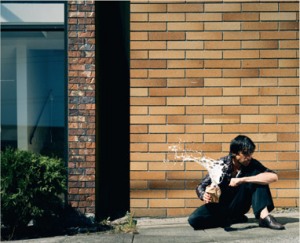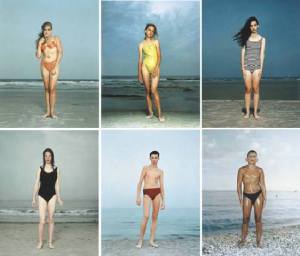Fried starts off with saying that works by Contemporary photographers such as Wall and Struth, among the many others discussed, are not any better than those who came before him such as Avedon, and Steiglitz and so on. He’s saying that the difference in photographs now is that they can raise the question of the limits of representation and the critique of representation.
As we all know photography is a pretty young medium and the masters he talks about in his book were exploring the techniques and the discipline of the craft. I feel like much of the early photography was about the object. They were exploring the world through this new medium and documenting what they came across, there was no big concepts or theory behind the works.

 Alfred Steiglitz on the left, Richard Avedon on the right.
Alfred Steiglitz on the left, Richard Avedon on the right.
With contemporary photography the artist and the art have become more complicated and complex, much like the rest of the world we live in. We have become inthralled with the meaning behind the photograph we see hanging on the wall before us, to the point where I’ve been told by teachers that if my work doesn’t have a theoretical concept behind the images then it’s worthless, those exact words weren’t used but it was the general feeling I received. I think a photograph is good if it provokes a preferable emotion or experience from being viewed, it doesn’t have to have a long theorized meaning behind it for me to consider it good art. It’s interesting how people can easily tell you what bad art is but it’s a more difficult time when explaining what art is good and I guess Fried is saying that work that can be theorized is good “art”.
I look at Jeff Wall’s work and am left wondering why I should care about the photograph. I don’t experience it and am uninterested in the concepts behind the photographs, they don’t cater to my interests in a photograph.
Fried quotes Walter Benn Michaels who says “We do not experience the fossil as a trilobite, but we do not experience it as the picture of a trilobite”. I get that Wall’s photographs often pay homage to famous works throughout art history but I honestly don’t care and for me it does nothing to enhance the photo, I’ve never been able to get into art history and I find myself bored learning about Wall and the theory behind why he is such a great artist.
When it comes to contemporary portrait photographers, like Rene Dijkstra and Tina Barney, there is this weird interaction happening now between the absorption of the subject and at the same time the intentional act of not being viewed, and Fried credits this to the medium of photography alone a for of to-be-seenness.
Tian Barney and Rene Dijkstra
With contemporary portraiture the job of the photographer is to successfully influence the viewer to see the photography itself, to show the sitters truth. In both works shown above the subjects are posing for the camera, Barney’s posed to looks like snapshots and Dijkstra’s a more formal straight on pose. I enjoy Barney’s photograph because they feel real even though I know they are posed, I am able to convince myself that this would be a natural event on any given day and as a classmate said they are the snapshot aesthetic made formal. On the other hand Dijkstra’s photographs feel so sterile and at some times the poses feel unnatural to me and I find myself again bored with the viewing experience.
Maybe it’s because Wall and Dijkstra are talking about more theory based ideas about the human condition and issues pertaining to reality but I prefer my experience to take me away from reality and into a world more like my own mind. I’ll again use Kahn and Selesnick’s work as an example.

I know they are constructed and composited photographs but at the purest level they talk about a reality that is not our own and it becomes a form of escapism for me (viewer) and for my own personal taste I enjoy the experience more than that of looking at a photograph by Wall.
I find it hard to be connected with Fried’s thoughts on the contemporary, mainly because of his writing style.











